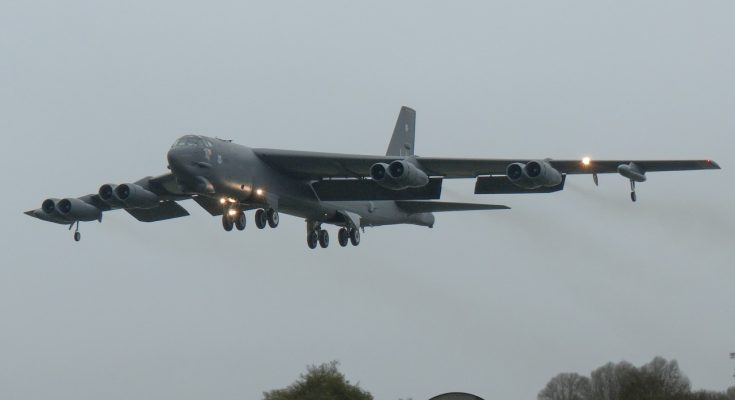In February 2025, a B-52 Stratofortress bomber landed in Europe, further solidifying its strategic importance within the U.S. Air Force and NATO’s defense posture. This iconic aircraft, known for its long-range capabilities and payload versatility, continues to play a pivotal role in the U.S. military’s global operations, especially as tensions in Europe and surrounding regions remain high. The B-52’s arrival in Europe is part of ongoing efforts to bolster NATO’s deterrence capabilities in the face of evolving threats from near-peer adversaries like Russia and China.
The B-52: A Legacy of Power and Precision
The B-52 Stratofortress first entered service in the 1950s, and it remains one of the longest-serving aircraft in the U.S. Air Force. Designed for strategic bombing, the B-52 has proven its worth as a nuclear-capable, long-range platform that can deliver both conventional and nuclear payloads over vast distances. Although it’s often associated with cold war-era deterrence, the B-52 has been continually updated with modern avionics, engines, and weapons systems to remain effective in contemporary warfare. Its flexibility in carrying a wide array of munitions, including precision-guided bombs, cruise missiles, and nuclear bombs, makes it a crucial asset for the U.S. military.
Strengthening NATO’s Deterrence and Response
The arrival of a B-52 in Europe sends a powerful signal to NATO’s adversaries, particularly in light of rising tensions in Eastern Europe. With the ongoing conflict in Ukraine and the increasing instability along NATO’s eastern borders, the presence of advanced U.S. bombers in Europe serves as a clear demonstration of the alliance’s commitment to collective defense.
The bomber’s presence provides a clear strategic advantage, reinforcing NATO’s deterrence capabilities. The B-52 can perform show-of-force operations, fly high-profile missions along NATO’s borders, and conduct joint exercises with allied air forces. This helps to ensure that NATO members maintain a credible military threat and can respond rapidly to any aggression in the region.
Additionally, the B-52 is capable of carrying out rapid-response missions. Its long-range and extended loiter time make it an ideal platform for conducting reconnaissance, strike, and escort operations. By positioning such an aircraft in Europe, the U.S. and NATO enhance their ability to quickly counter any potential threats, whether they arise from land, sea, or air.
Increased Training and Integration with Allies
The arrival of the B-52 also plays a role in enhancing interoperability between NATO forces. The aircraft’s participation in joint training exercises with European allies provides an opportunity to practice coordination in high-intensity scenarios, ranging from conventional warfare to nuclear deterrence operations. By integrating the B-52 into NATO’s training routines, allied forces can familiarize themselves with U.S. tactics, techniques, and procedures, which strengthens the alliance’s collective readiness.
In recent years, there has been a growing focus on ensuring that NATO’s various member states are prepared to respond to crises in a unified and coordinated manner. The B-52’s involvement in these exercises underscores the importance of air power in modern warfare, especially in a region where air superiority remains a key factor in achieving success in conflicts.
A Symbol of U.S. Commitment
The arrival of another B-52 bomber in Europe is not only a display of military capability, but also a symbol of U.S. commitment to the security of NATO and its allies. As global security dynamics continue to evolve, the U.S. Air Force has maintained a steady presence in Europe to ensure that NATO forces remain ready to counter any potential threat.
With the B-52 capable of conducting missions over vast distances, including deep into hostile territory, its presence in Europe serves as a deterrent to any nation considering aggression against NATO. The aircraft’s global reach, combined with its impressive endurance and payload capacity, ensures that NATO can continue to maintain a powerful and flexible response to threats on its eastern and southern flanks.
The Future of the B-52 in Europe
As the B-52 continues to evolve, it will remain a key component of the U.S. military’s long-range strike capabilities. In addition to traditional bomber operations, the B-52 is expected to integrate with emerging technologies such as hypersonic weapons and unmanned systems in the coming years. Its arrival in Europe will likely continue to be a regular occurrence, especially as the U.S. and NATO reinforce their presence in response to geopolitical tensions.
Ultimately, the B-52’s role in Europe is emblematic of the growing need for multidimensional military capabilities in a rapidly changing security environment. Whether engaging in strategic deterrence, precision strike, or air dominance operations, the B-52’s legacy and continued relevance will ensure its place as a cornerstone of NATO’s defense strategy for years to come.



